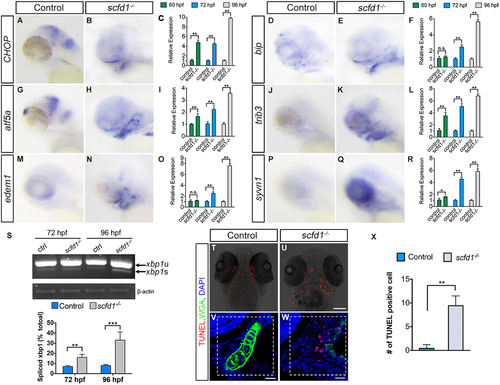Fig. 4
|
The UPR is activated in scfd1 mutant embryos coincident with up-regulated cell death. (A, B, D, E, G, H, J, K, M, N, P and Q) Whole mount in situ hybridization of 72 hpf wild type and scfd1 mutant embryos using probes against ditt3, hspa5, atf5, trib3, edem1 and syvn1. Lateral views with anterior to the left. (C, F, I, L, O and R) Q-PCR experiments confirmed up-regulation of UPR-associated genes in scfd1 mutants. Error bars represent mean±SEM. (S) Elevated xbp1 mRNA splicing was detected by RT-PCR and Q-PCR. xbp1-u, unspliced xbp1 mRNA. xbp1-s, spliced xbp1 mRNA. β-actin was as a loading control for RT PCR. Percentage of spliced xbp1 mRNA determined by the percentage of spliced/total mRNA. Error bars indicate s.e.m. n.s., not significant. **P<0.01 and *P<0.05 as determined by Student's t-tests (C, F, I, L, O and R). (T–X) Enhanced cell death in scfd1 mutants. Ventral view with anterior to the top. (V, W and X) Quantification of TUNEL-positive cells counted on a 0.016 mm2 field (dashed line square). 8 sections for each genotype were analyzed and representative samples are shown. Error bars indicate s.e.m. **P<0.01 as determined by Student's t-tests. Scale bars: 25 µm. |
| Genes: | |
|---|---|
| Fish: | |
| Anatomical Terms: | |
| Stage Range: | Pec-fin to Day 4 |
| Fish: | |
|---|---|
| Observed In: | |
| Stage Range: | Pec-fin to Day 4 |
Reprinted from Developmental Biology, 421(1), Hou, N., Yang, Y., Scott, I.C., Lou, X., The Sec domain protein Scfd1 facilitates trafficking of ECM components during chondrogenesis, 8-15, Copyright (2017) with permission from Elsevier. Full text @ Dev. Biol.

